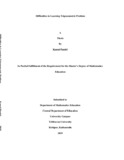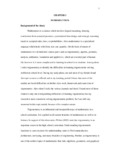Please use this identifier to cite or link to this item:
https://elibrary.tucl.edu.np/handle/123456789/1861Full metadata record
| DC Field | Value | Language |
|---|---|---|
| dc.contributor.author | Paudel, Kamal | |
| dc.date.accessioned | 2021-04-15T09:48:14Z | |
| dc.date.accessioned | 2021-07-23T02:48:50Z | - |
| dc.date.available | 2021-04-15T09:48:14Z | |
| dc.date.available | 2021-07-23T02:48:50Z | - |
| dc.date.issued | 2019 | |
| dc.identifier.uri | http://elibrary.tucl.edu.np/handle/123456789/1861 | - |
| dc.description.abstract | The major purpose of this study was to explore the difficulties in learning trigonometric problem and analyze its causes at grade IX students. The study was carried out on four private schools of Kaski district that were selected through purposive sampling. In this research I selected hundred students for achievement test. Among them seven students, whose performance is not satisfactory were selected for interview. The case study research design was used in this qualitative research. Data were collected from diagnostics test, observation and in-depth interview schedules. The collected data was analyzed by general inductive approach. After collection the data from the achievement test, class observation and interview, difficulties in learning trigonometric were categorized in two topics as conceptual and procedural difficulties. Similarly the causes of difficulties in learning trigonometry were categorized as motivation, pre-knowledge, home/school environment, student's attitudes and misconception. In conceptual difficulties: students had difficulties in mathematical definition, symbolizing of mathematics terms, mathematical representation and notation. Similarly in procedural difficulties; students had difficulties in using formula, making connection between definition and problem, findings significant value, separating and multiplying the power of trigonometric terms and visualizing the objects. For the above difficulties reason involve that lack of conceptual knowledge, less practice at home, lack of confidence, teaching method, student's attitude towards trigonometry. Student didn't give clear solution of trigonometric problem. It is necessary to find suitable strategy to cover most of these difficulties for improving student's conceptual and procedural difficulties in trigonometry. The results of this analysis can help to select and design effectiveness learning strategy to rectify the mentioned difficulties. | en_US |
| dc.language.iso | en_US | en_US |
| dc.publisher | Central Department of Education Mathematics | en_US |
| dc.subject | Mathematics | en_US |
| dc.subject | Study | en_US |
| dc.subject | Classrooms | en_US |
| dc.title | Difficulties in Learning Trigonometric Problem | en_US |
| dc.type | Thesis | en_US |
| Appears in Collections: | English Language Education | |
Files in This Item:
| File | Description | Size | Format | |
|---|---|---|---|---|
| Cover Page(5).pdf | 80.58 kB | Adobe PDF |  View/Open | |
| Chapter Page-9.pdf | 1.55 MB | Adobe PDF |  View/Open |
Items in DSpace are protected by copyright, with all rights reserved, unless otherwise indicated.
